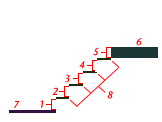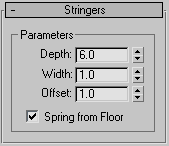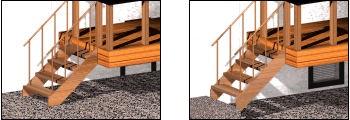You can create four different types of stairs in 3ds Max: Spiral Stair, Straight Stair, L-Type Stair, or U-Type Stair.
- To pan the viewport, scroll the mouse wheel or drag with the middle mouse button.
- To orbit the viewport, press and hold Alt while scrolling the mouse wheel or dragging with the middle mouse button.
- To zoom the viewport, scroll the mouse wheel or hold down Alt+Ctrl and drag forward and back with the middle mouse button.
Stairs and Materials
By default, 3ds Max assigns seven different material IDs to stairs. The aectemplates.mat material library includes Stair-Template, a Multi/Sub-Object material designed to be used with stairs. Each component of the stair/material is listed below along with its corresponding Material ID.
| Material ID | Railing/Material Component |
|---|---|
| 1 | Treads of the stairs |
| 2 | Front riser of the stairs |
| 3 | Bottom, back, and sides of the risers of the stairs |
| 4 | Center pole of the stairs |
| 5 | Handrails of the stairs |
| 6 | Carriage of the stairs |
| 7 | Stringers of the stairs |
Procedures
To create railings on stairs:
- Create the stairs. See individual stair-type topics for more information.
- In the Generate Geometry group, turn on Rail Path
 Left and Right.
Left and Right. 3ds Max places left and right rail paths above the stairs.
- In the Railings rollout, set Height to 0.0.
- Click
 Create panel
Create panel  AEC Extended
AEC Extended  Railing to create the first railing.
Railing to create the first railing. - Click Railing rollout
 Pick Railing Path and select one of the rail paths on the stairs.
Pick Railing Path and select one of the rail paths on the stairs. - Adjust the railing parameters.
3ds Max remembers the parameters you set. When you create the next railing, it will have the same parameters as you set for the first railing.
- Right-click to end the creation of the first railing.
- Click Railing again to create the second railing.
- Click Pick Railing Path and select the other rail path on the stairs.
Interface
Object Type rollout

- Stair Selection Buttons
-
Click one of these to specify the type of stairs you want to create.
Name and Color rollout
This rollout lets you set the stairs object's name and color. For detailed information, see Object Name and Wireframe Color.
Parameters rollout
Type group

- Open Creates an open riser stair.
- Closed Creates a closed riser stair.
- Box Creates a stair with closed risers and closed stringers on both sides.
Rise group

3ds Max keeps one Rise option locked while you adjust the other two. To lock an option, you click a push pin. To unlock an option you click a raised push pin. 3ds Max locks the spinner value of the parameter with the depressed push pin and allows the spinner values of the parameter with the raised push pins to change.
- Overall
-
Controls the height of the flight of stairs.
- Riser Ht
-
Controls the height of the risers.
- Riser Ct
-
Controls the number of risers. There will always be one more riser than steps. This implied riser is between the top step of the stair and the upper floor.

Linear stair with five risers
1 through 4. Risers
5. The implied riser
6. The upper floor you snap to
7. The lower floor you snap to
8. The steps
Stringers rollout
These controls are available only when you turn on Stringers on the Parameters rollout  Generate Geometry group.
Generate Geometry group.

- Depth
-
Controls how far down the stringers reach toward the floor.
- Width
-
Controls the width of the stringers.
- Offset
-
Controls the vertical distance of the stringers from the floor.
- Spring from Floor
-
Controls whether the stringer starts at the floor, flush with the start of the first riser, or if the stringer extends below the floor. You control the amount the stringer extends below the floor with the Offset option.

Left: The stringer extending below the floor. (Spring From Floor off.)
Right: The stringer springing from the floor. (Spring From Floor on.)
Carriage rollout
These controls are available only when you turn on Carriage on the Parameters rollout  Generate Geometry group.
Generate Geometry group.

- Depth
-
Controls how far down the carriage reaches toward the floor.
- Width
-
Controls the width of the carriage.
-
 Carriage Spacing
Carriage Spacing -
Sets the spacing of the carriage. When you click this button, the Carriage Spacing dialog displays. Specify the number of carriages you want using the Count option. For more information on spacing options in this dialog, see Spacing Tool.
- Spring from Floor
-
Controls whether the carriage starts at the floor, flush with the start of the first riser, or if the carriage extends below the floor. You control the amount the carriage extends below the floor with the Offset option.

Left: The carriage springing from the floor. (Spring From Floor on.)
Right: The carriage extending below the floor. (Spring from Floor off.)
Railings rollout
These controls are available only when you turn on one or more of the Handrail or Rail Path options on the Parameters rollout  Generate Geometry group. Also, Segments and Radius aren't available if neither of the Handrail options is on.
Generate Geometry group. Also, Segments and Radius aren't available if neither of the Handrail options is on.

- Height
-
Controls the height of the railings from the steps.
- Offset
-
Controls the offset of the railings from the ends of the steps.
- Segments
-
Controls the number of segments in the railings. Higher values display smoother railings.
- Radius
-
Controls the thickness of the railings.